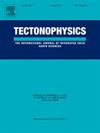Study of well data reveals fluid pressure distribution and origin in the upper crust of the Irpinia region (Southern Apennines, Italy)
IF 2.7
3区 地球科学
Q2 GEOCHEMISTRY & GEOPHYSICS
引用次数: 0
Abstract
This study investigates subsurface pore pressures in the Irpinia region of southern Apennines, Italy, one of the central Mediterranean areas with the highest seismic activity. The Apennine thrust belt consists of stacked thrust sheets formed from both deep- and shallow-water environments during the pre-orogenic phase and later involved in the Neogene compressional phase. In the ongoing post-orogenic phase, the region is experiencing an extensional tectonic regime, as evidenced by the 1980 Ms. 6.9 normal fault Irpinia earthquake. Eleven exploration wells drilled to depth of 1.7–5.9 km intersect the main tectonostratigraphic units of the chain, providing valuable data on drilling mud weights and fluid chemical features, allowing for the reconstruction of vertical pore pressure trends and fluid circulation through the upper crust up to nearly 6 km of depth. The data analysis reveals that the carbonate platform and basin Meso-Cenozoic deposits generally exhibit hydrostatic or nearly hydrostatic conditions in the upper 2–4 km depth. However, moderate to high overpressure gradients are observed in Meso-Cenozoic basin sequences, Messinian evaporites, tectonic mélange, and foredeep Pliocene shales. These overpressures are typically associated with reverse faults and are not correlated with occurrences of gas. Conversely, slight overpressure gradients at shallower depths are related to shaly lithologies containing gas traces. Notably, the pressure profile of San Gregorio Magno-1 well, intersecting the causative fault of the 1980 earthquake, suggests a uniform distribution of fluids throughout intensively fractured nappes, including carbonate platform units and deep-water basin formations. Moreover, wells that penetrated the buried platform carbonates, known as Apulian carbonates, display hydrostatic or low overpressure gradients, even when overpressured shales seal the carbonate reservoirs, challenging previous seismological interpretations of overpressured Apulian carbonates. Finally, the analysis of diffusion mechanisms has provided insights into the timing of the geological disturbance that caused the locally observed overpressures and their maintenance.
意大利南亚平宁地区伊尔皮尼亚地区上地壳流体压力分布及成因研究
本研究调查了意大利亚平宁山脉南部伊尔皮尼亚地区的地下孔隙压力,该地区是地中海中部地震活动最频繁的地区之一。亚平宁冲断带由前造山期深水和浅水环境形成的叠合冲断片组成,后经历了新近系挤压期。在正在进行的造山期后,该地区正在经历一个伸展构造制度,如1980年伊尔皮尼亚6.9级正断层地震。11口钻探深度为1.7-5.9 km的探井相交于该链的主要构造地层单元,提供了有关钻井泥浆重量和流体化学特征的宝贵数据,从而可以重建垂向孔隙压力趋势和近6 km深度的上地壳流体循环。资料分析表明,碳酸盐岩台地和盆地中新生代沉积在2 ~ 4 km以上深度普遍表现为静水或近静水条件。而在中新生代盆地层序、墨西旦期蒸发岩、构造界和上新世前深层页岩中,均存在中等至较高的超压梯度。这些超压通常与逆断层有关,而与天然气的赋存无关。相反,在较浅的深度,轻微的超压梯度与含有气体痕迹的泥质岩性有关。值得注意的是,与1980年地震的成因断层相交的San Gregorio Magno-1井的压力剖面表明,流体在密集断裂推覆体中分布均匀,包括碳酸盐台地单元和深水盆地地层。此外,即使超压页岩封住了碳酸盐岩储层,穿透埋藏台地碳酸盐岩(即Apulian碳酸盐岩)的井也显示出静流体或低超压梯度,这挑战了之前对Apulian超压碳酸盐岩的地震解释。最后,通过对扩散机制的分析,可以深入了解引起局部超压的地质扰动的时间及其维持。
本文章由计算机程序翻译,如有差异,请以英文原文为准。
求助全文
约1分钟内获得全文
求助全文
来源期刊

Tectonophysics
地学-地球化学与地球物理
CiteScore
4.90
自引率
6.90%
发文量
300
审稿时长
6 months
期刊介绍:
The prime focus of Tectonophysics will be high-impact original research and reviews in the fields of kinematics, structure, composition, and dynamics of the solid arth at all scales. Tectonophysics particularly encourages submission of papers based on the integration of a multitude of geophysical, geological, geochemical, geodynamic, and geotectonic methods
 求助内容:
求助内容: 应助结果提醒方式:
应助结果提醒方式:


